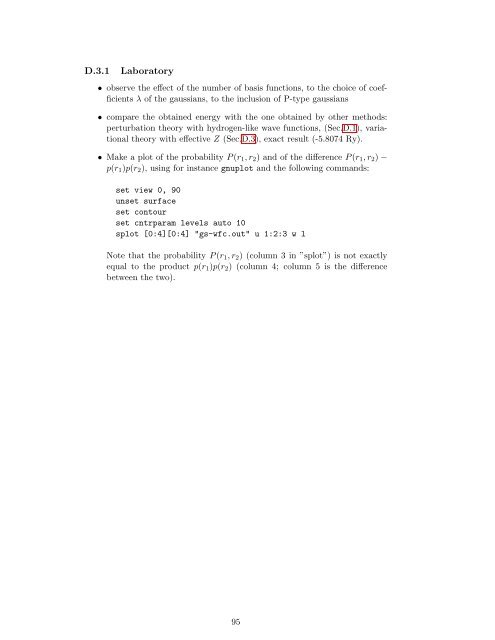Numerical Methods in Quantum Mechanics - Dipartimento di Fisica
Numerical Methods in Quantum Mechanics - Dipartimento di Fisica
Numerical Methods in Quantum Mechanics - Dipartimento di Fisica
Create successful ePaper yourself
Turn your PDF publications into a flip-book with our unique Google optimized e-Paper software.
D.3.1<br />
Laboratory<br />
• observe the effect of the number of basis functions, to the choice of coefficients<br />
λ of the gaussians, to the <strong>in</strong>clusion of P-type gaussians<br />
• compare the obta<strong>in</strong>ed energy with the one obta<strong>in</strong>ed by other methods:<br />
perturbation theory with hydrogen-like wave functions, (Sec.D.1), variational<br />
theory with effective Z (Sec.D.3), exact result (-5.8074 Ry).<br />
• Make a plot of the probability P (r 1 , r 2 ) and of the <strong>di</strong>fference P (r 1 , r 2 ) −<br />
p(r 1 )p(r 2 ), us<strong>in</strong>g for <strong>in</strong>stance gnuplot and the follow<strong>in</strong>g commands:<br />
set view 0, 90<br />
unset surface<br />
set contour<br />
set cntrparam levels auto 10<br />
splot [0:4][0:4] "gs-wfc.out" u 1:2:3 w l<br />
Note that the probability P (r 1 , r 2 ) (column 3 <strong>in</strong> ”splot”) is not exactly<br />
equal to the product p(r 1 )p(r 2 ) (column 4; column 5 is the <strong>di</strong>fference<br />
between the two).<br />
95
















